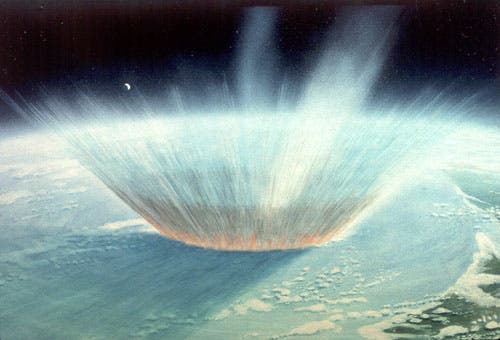If it weren’t for a city-sized asteroid that that slammed into Chicxulub, a gaping crater near the same-named city on Mexico’s Yucatan Peninsula, dinosaurs would have still dominated this planet. But then again, humans might have never evolved, so kudos to us. According to a new study which recalculated the angle of the asteroid impact, you certainly wouldn’t have wanted to be there when it happened. The 66-million-year-old impact unleashed an unforgiving global cooling event that was far worse than previously thought, scientists say.

This tragic event has remained etched permanently in the planet’s geological history, through a band called the K-T Boundary, which separates the Cretaceous and Tertiary periods in geologic history. That and the gaping scar of the 180-kilometer-wide crater rim called Chicxulub. All dinosaurs went extinct, along with 60 to 80 percent of all life on Earth.
Oddly enough, the crater was discovered only twenty years ago. Previously, scientists called to attention a thin layer of iridium that could be found in rocks all over the world and dated around the time of the dinosaurs’ demise. This material is extraterrestrial, typically found in asteroids, but also in some volcanic ejections. In 1991, Alan Hildebrand, a geologist at the University of Calgary in Canada, found shocked quartz and a layer of iridium-enriched dust in samples collected in the 1950s by Mexican geologists looking for oil at the Chicxulub, and this ultimately led to finding the crater.
In the 25 years since the asteroid’s impact point was identified, scientists have learned a lot about how this event altered the planet.
Now, British researchers at Imperial College London have come up with refined calculations that paint a more accurate picture of how it all went down one ominous day 66 million years ago.
“Many climate models can’t currently capture all of the consequences of the Chicxulub impact due to uncertainty in how much gas was initially released,” said Joanna Morgan, a geophysicist at Imperial College London in the United Kingdom, in a press release. “We wanted to revisit this significant event and refine our collision model to better capture its immediate effects on the atmosphere.”
Among the key findings was that a large amount of sulfur and a smaller amount of carbon dioxide were found to be ejected by the asteroid impact compared to other studies. For this reason, the team claims that the climatic consequences may have been more dramatic than we thought.
Based on a computer model that simulated the pressure of the impact’s shock waves, the British researchers estimate the asteroid collision released about 325 gigatons of sulfur and 425 gigatons of carbon dioxide into the atmosphere, more than 10 times global human emissions of carbon dioxide in 2014. The asteroid crashed into the Earth with the explosive force of 40,000 US nuclear warheads, all triggered in a matter of seconds.
In the aftermath of the cataclysmic chain of events, a cloud of dust and sulfur engulfed the whole planet, reflecting sunlight and dramatically cooling Earth’s surface temperature. According to the paper published in Geophysical Research Letters, Earth’s average surface air temperature dropped by as much as a staggering 26 degrees Celsius (47 degrees Fahrenheit). The sub-freezing temperatures persisted for over three years — enough to destroy plant life and everything else up the food web. Marine life likely had it even worse than terrestrial animals. It would have taken “hundreds of years after the Chicxulub impact” before ocean temperatures rebounded.


